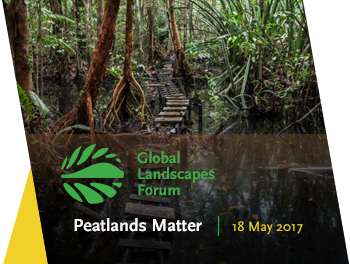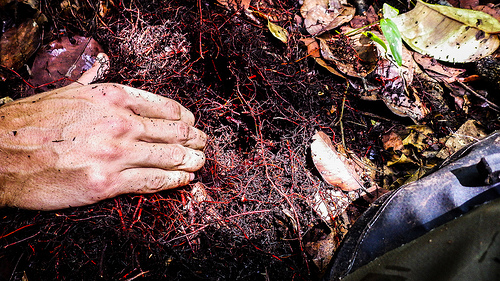From Peru to the Democratic Republic of Congo and the Republic of Congo to Indonesia, peatlands restoration and management efforts have been underway with increasing attention over the past few years. What have these efforts entailed thus far, and how can they increase and improve looking forward?
Scientists and policymakers voiced their distinct perspectives as they shared the national and local contexts, challenges, best practices and opportunities for improving peatlands management around the world during the plenary session entitled, Peatlands around the world: Challenges and opportunities during the Global Landscapes Forum: Peatlands Matter thematic event in Jakarta on May 18.
The Forum brought together 425 diverse stakeholders from the government, private sector, science and civil society to accelerate positive action in the management of global peatlands.
Dennis del Castillo, Director of the Forest Management and Environmental Service Program at the Peruvian Amazon Research Institute (IIAP), was a speaker on the panel. Del Castillo sat down with Forests News’ Editor-in-Chief Leona Liu after his session to discuss Peru’s actions towards the sustainable management of its peatlands.
*Read the full transcript of the TV interview below
Why should we care about peatlands?
Well, basically we need a lot of education about peatlands because in general, peatlands are looked at as a ‘wasteland’, which is not the case. Peatlands play an enormous role in terms of climate mitigation and also, in the livelihoods of people who are living in those areas. So peatlands don’t mean wastelands at all; they are actually very productive lands.
That’s an interesting remark that people view peatlands as wastelands. Why do you think they have this impression?
That’s because what happens is when you see peatlands, you are looking at different swamps where you are going to find different snakes and animals, so almost everyone is afraid [of them]. So many people believe they are wastelands. That’s not the case; they simply mean life.
Peatlands often fall into the grey zone between economic conservation and economic development. Sometimes these interests might conflict. What do you think is the best way to reconcile these interests and to create more communication between governments and local communities when it comes to managing peatlands?
What’s happening is, because of our education, we believe some people are foresters, other people are agronomists, other people are biologists, and other people are fisheries managers… and then we all go in different directions.
But when we talk about peatlands, we have to work together to understand each other. Because that’s the only way to understand what peatlands are all about and how to manage them. If we all go in different directions, we are wasting our time because we are losing the opportunity to work together to best manage them.
Can you tell me a bit about the situation of peatlands in Peru, where you live?
Sure, it’s a very special place. First of all, I want to make the difference between peatlands here in Indonesia and peatlands in Peru. [Regarding] peatlands in Indonesia, most of them are destroyed because of a lot of oil palm plantations.
What’s happening in Peru is quite different. Over there, we have different fruits. As a matter of fact, I talked this morning about the Aguaje palm tree. It’s a very delicious fruit. And we have five million hectares of that fruit. That plant provides us with an economy, food and biodiversity. So our approach in Peru is how to preserve and manage those peatlands with a lot of Aguaje, the palm I’m talking about. We have that approach rather than destroy the peatlands. And that’s the difference we have regarding peatlands in the Peruvian Amazon and here in Indonesia.
In Indonesia, after the fire and haze crisis of 2015, the Indonesian government instituted a ‘no burn’ policy on peatlands. Does the Peruvian government have similar policies in place?
We don’t have those kinds of problems in terms of burning peatlands because [in Peru] the approach is saving those peatlands because we already have products coming from peatlands like Aguaje fruit, fish, timber and so on.
So we are taking care of peatlands because that’s our economy. We don’t need to destroy them. We need to keep helping the local people and the national economy.
You have a lot of experience working with local communities. What do you think is the best way to engage them and mobilize them to get involved in sustainable peatland management?
I’ll tell you something- I was lucky to work in different parts of the world. I worked in Africa; I worked in the Amazon. I believe the approach that works best is just to go with an open mind, to talk with the local farmers and try to learn from them.
We make a big mistake when we go over there and try to teach them how to manage their biodiversity. The local farmers are the best of the best when it comes to local management of biodiversity.
And Dennis, what drew you here today to the Global Landscapes Forum?
Just trying to learn how [Indonesia] is dealing with peatlands here. And also to exchange ideas with people from other places- from Africa, from other parts of Asia, even from the Amazon because I met some Peruvians over here that I never met in Peru, so it’s a good opportunity to exchange experiences and to see how we can work more closely together in the future on these very important issues.
*This is part of a series of video interviews from the 2017 Global Landscapes Forum: Peatlands Matter thematic event in Jakarta, Indonesia
We want you to share Forests News content, which is licensed under Creative Commons Attribution-NonCommercial-ShareAlike 4.0 International (CC BY-NC-SA 4.0). This means you are free to redistribute our material for non-commercial purposes. All we ask is that you give Forests News appropriate credit and link to the original Forests News content, indicate if changes were made, and distribute your contributions under the same Creative Commons license. You must notify Forests News if you repost, reprint or reuse our materials by contacting forestsnews@cifor-icraf.org.

